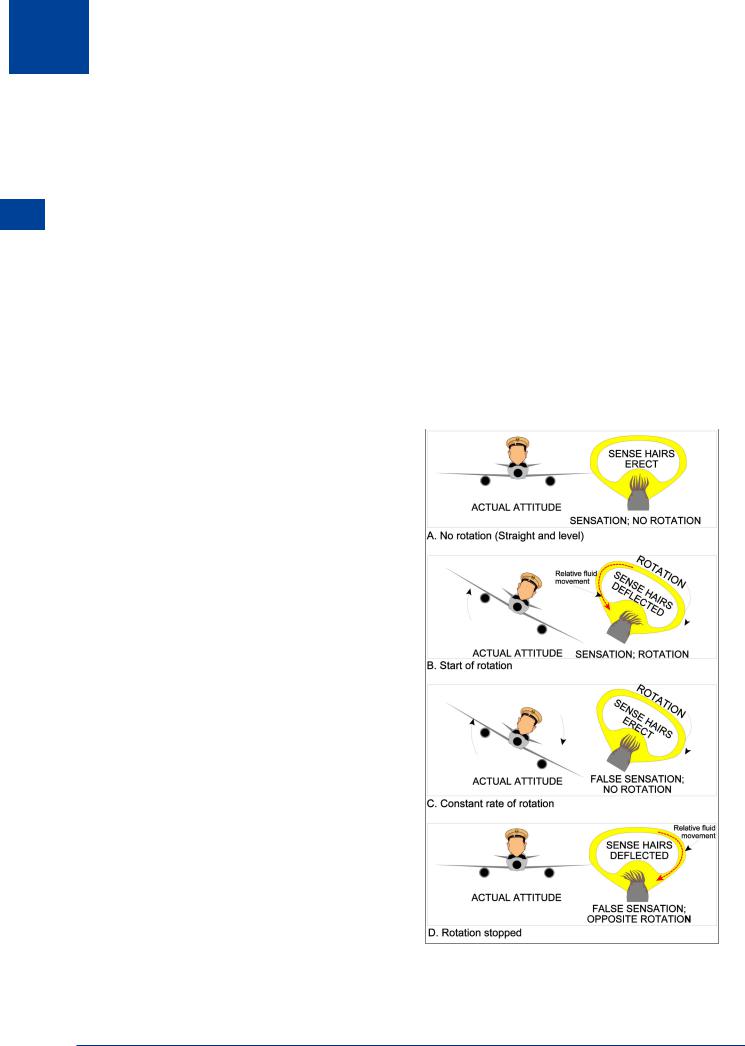
- •Textbook Series
- •Contents
- •1 Basic Concepts
- •The History of Human Performance
- •The Relevance of Human Performance in Aviation
- •ICAO Requirement for the Study of Human Factors
- •The Pilot and Pilot Training
- •Aircraft Accident Statistics
- •Flight Safety
- •The Most Significant Flight Safety Equipment
- •Safety Culture
- •Reason’s Swiss Cheese Model
- •The Five Elements of Safety Culture
- •Flight Safety/Threat and Error Management
- •Threats
- •Errors
- •Undesired Aircraft States
- •Duties of Flight Crew
- •2 The Circulation System
- •Blood Circulation
- •The Blood
- •Composition of the Blood
- •Carriage of Carbon Dioxide
- •The Circulation System
- •What Can Go Wrong
- •System Failures
- •Factors Predisposing to Heart Attack
- •Insufficient Oxygen Carried
- •Carbon Monoxide
- •Smoking
- •Blood Pressure
- •Pressoreceptors and their Function Maintaining Blood Pressure
- •Function
- •Donating Blood and Aircrew
- •Pulmonary Embolism
- •Questions
- •Answers
- •3 Oxygen and Respiration
- •Oxygen Intake
- •Thresholds of Oxygen Requirements Summary
- •Hypoxic Hypoxia
- •Hypoxic Hypoxia Symptoms
- •Stages/Zones of Hypoxia
- •Factors Determining the Severity of and the Susceptibility to Hypoxic Hypoxia
- •Anaemic Hypoxia
- •Time of Useful Consciousness (TUC)
- •Times of Useful Consciousness at Various Altitudes
- •Effective Performance Time (EPT)
- •Hyperventilation
- •Symptoms of Hyperventilation
- •Hypoxia or Hyperventilation?
- •Cabin Pressurization
- •Cabin Decompression
- •Decompression Sickness (DCS)
- •DCS in Flight and Treatment
- •Questions
- •Answers
- •4 The Nervous System, Ear, Hearing and Balance
- •Introduction
- •The Nervous System
- •The Sense Organs
- •Audible Range of the Human Ear and Measurement of Sound
- •Hearing Impairment
- •The Ear and Balance
- •Problems of Balance and Disorientation
- •Somatogyral and Somatogravic Illusions
- •Alcohol and Flying
- •Motion Sickness
- •Coping with Motion Sickness
- •Questions
- •Answers
- •5 The Eye and Vision
- •Function and Structure
- •The Cornea
- •The Iris and Pupil
- •The Lens
- •The Retina
- •The Fovea and Visual Acuity
- •Light and Dark Adaptation
- •Night Vision
- •The Blind Spot
- •Stereopsis (Stereoscopic Vision)
- •Empty Visual Field Myopia
- •High Light Levels
- •Sunglasses
- •Eye Movement
- •Visual Defects
- •Use of Contact Lenses
- •Colour Vision
- •Colour Blindness
- •Vision and Speed
- •Monocular and Binocular Vision
- •Questions
- •Answers
- •6 Flying and Health
- •Flying and Health
- •Acceleration
- •G-forces
- •Effects of Positive G-force on the Human Body
- •Long Duration Negative G
- •Short Duration G-forces
- •Susceptibility and Tolerance to G-forces
- •Summary of G Tolerances
- •Barotrauma
- •Toxic Hazards
- •Body Mass Index (BMI)
- •Obesity
- •Losing Weight
- •Exercise
- •Nutrition and Food Hygiene
- •Fits
- •Faints
- •Alcohol and Alcoholism
- •Alcohol and Flying
- •Drugs and Flying
- •Psychiatric Illnesses
- •Diseases Spread by Animals and Insects
- •Sexually Transmitted Diseases
- •Personal Hygiene
- •Stroboscopic Effect
- •Radiation
- •Common Ailments and Fitness to Fly
- •Drugs and Self-medication
- •Anaesthetics and Analgesics
- •Symptoms in the Air
- •Questions
- •Answers
- •7 Stress
- •An Introduction to Stress
- •The Stress Model
- •Arousal and Performance
- •Stress Reaction and the General Adaption Syndrome (GAS)
- •Stress Factors (Stressors)
- •Physiological Stress Factors
- •External Physiological Factors
- •Internal Physiological Factors
- •Cognitive Stress Factors/Stressors
- •Non-professional Personal Factors/Stressors
- •Stress Table
- •Imaginary Stress (Anxiety)
- •Organizational Stress
- •Stress Effects
- •Coping with Stress
- •Coping with Stress on the Flight Deck
- •Stress Management Away from the Flight Deck
- •Stress Summary
- •Questions
- •Answers
- •Introduction
- •Basic Information Processing
- •Stimuli
- •Receptors and Sensory Memories/Stores
- •Attention
- •Perception
- •Perceived Mental Models
- •Three Dimensional Models
- •Short-term Memory (Working Memory)
- •Long-term Memory
- •Central Decision Maker and Response Selection
- •Motor Programmes (Skills)
- •Human Reliability, Errors and Their Generation
- •The Learning Process
- •Mental Schema
- •Questions
- •Answers
- •9 Behaviour and Motivation
- •An Introduction to Behaviour
- •Categories of Behaviour
- •Evaluating Data
- •Situational Awareness
- •Motivation
- •Questions
- •Answers
- •10 Cognition in Aviation
- •Cognition in Aviation
- •Visual Illusions
- •An Illusion of Movement
- •Other Sources of Illusions
- •Illusions When Taxiing
- •Illusions on Take-off
- •Illusions in the Cruise
- •Approach and Landing
- •Initial Judgement of Appropriate Glideslope
- •Maintenance of the Glideslope
- •Ground Proximity Judgements
- •Protective Measures against Illusions
- •Collision and the Retinal Image
- •Human Performance Cognition in Aviation
- •Special Situations
- •Spatial Orientation in Flight and the “Seat-of-the-pants”
- •Oculogravic and Oculogyral Illusions
- •Questions
- •Answers
- •11 Sleep and Fatigue
- •General
- •Biological Rhythms and Clocks
- •Body Temperature
- •Time of Day and Performance
- •Credit/Debit Systems
- •Measurement and Phases of Sleep
- •Age and Sleep
- •Naps and Microsleeps
- •Shift Work
- •Time Zone Crossing
- •Sleep Planning
- •Sleep Hygiene
- •Sleep and Alcohol
- •Sleep Disorders
- •Drugs and Sleep Management
- •Fatigue
- •Vigilance and Hypovigilance
- •Questions
- •Answers
- •12 Individual Differences and Interpersonal Relationships
- •Introduction
- •Personality
- •Interactive Style
- •The Individual’s Contribution within a Group
- •Cohesion
- •Group Decision Making
- •Improving Group Decision Making
- •Leadership
- •The Authority Gradient and Leadership Styles
- •Interacting with Other Agencies
- •Questions
- •Answers
- •13 Communication and Cooperation
- •Introduction
- •A Simple Communications Model
- •Types of Questions
- •Communications Concepts
- •Good Communications
- •Personal Communications
- •Cockpit Communications
- •Professional Languages
- •Metacommunications
- •Briefings
- •Communications to Achieve Coordination
- •Synchronization
- •Synergy in Joint Actions
- •Barriers to Crew Cooperation and Teamwork
- •Good Team Work
- •Summary
- •Miscommunication
- •Questions
- •Answers
- •14 Man and Machine
- •Introduction
- •The Conceptual Model
- •Software
- •Hardware and Automation
- •Intelligent Flight Decks
- •Colour Displays
- •System Active and Latent Failures/Errors
- •System Tolerance
- •Design-induced Errors
- •Questions
- •Answers
- •15 Decision Making and Risk
- •Introduction
- •The Mechanics of Decision Making
- •Standard Operating Procedures
- •Errors, Sources and Limits in the Decision-making Process
- •Personality Traits and Effective Crew Decision Making
- •Judgement Concept
- •Commitment
- •Questions
- •Answers
- •16 Human Factors Incident Reporting
- •Incident Reporting
- •Aeronautical Information Circulars
- •Staines Trident Accident 1972
- •17 Introduction to Crew Resource Management
- •Introduction
- •Communication
- •Hearing Versus Listening
- •Question Types
- •Methods of Communication
- •Communication Styles
- •Overload
- •Situational Awareness and Mental Models
- •Decision Making
- •Personality
- •Where We Focus Our Attention
- •How We Acquire Information
- •How We Make Decisions
- •How People Live
- •Behaviour
- •Modes of Behaviour
- •Team Skill
- •18 Specimen Questions
- •Answers to Specimen Papers
- •Revision Questions
- •Answers to Revision Questions
- •Specimen Examination Paper
- •Answers to Specimen Examination Paper
- •Explanations to Specimen Examination Paper
- •19 Glossary
- •Glossary of Terms
- •20 Index

Balance and Hearing Ear, System, Nervous The 4
4 |
The Nervous System, Ear, Hearing and Balance |
|||
Somatogyral and Somatogravic Illusions |
||||
|
||||
|
Whereas there are various differing definitions of these two illusions, it has been confirmed |
|||
|
that the following (extracted from “Fundamentals of Aerospace Medicine” by R.L. Dehart), are |
|||
|
accepted: |
|||
|
Somatogyral Illusion |
|||
|
The somatogyral illusion results from the inability of the semicircular canals to register accurately |
|||
|
a prolonged rotation (sustained angular velocity). If a turn is prolonged the sensation of turning |
|||
|
is gradually diminished as the hairs in the semicircular canals straighten. If the turn is then |
|||
|
either decreased or the aircraft levelled, the pilot has the sensation of turning in the opposite |
|||
|
direction as the hairs are again displaced. Thus a somatogyral illusion is the sensation of turning |
|||
|
in the opposite direction that occurs whenever the body undergoes angular deceleration from |
|||
|
a condition of sustained angular velocity. |
|||
|
“The Graveyard Spin” is a term used to describe the result of an incorrect recovery from a spin |
|||
|
caused by the Somatogyral Illusion and which may lead to disaster. |
|||
|
During a prolonged spin, the fluid (endolymph) |
|
|
|
|
|
|||
|
within the semicircular canals settles, thereby |
|||
|
allowing the sensing hairs to erect. When a |
|||
|
recovery from the spin is initiated (as in the case |
|||
|
of a prolonged turn), the hairs of semicircular |
|||
|
canals again are moved, giving the pilot a |
|||
|
strong sensation of entering in a spin in the |
|||
|
opposite direction. If he/she succumbs and |
|||
|
reacts to this incorrect information, the pilot |
|||
|
will re-enter the spin in the original direction. |
|||
|
Somatogravic Illusion. |
|||
|
The illusion of pitching up or down as a result |
|||
|
of the movement of the Otoliths due to linear |
|||
|
acceleration. On take-off this is exacerbated |
|||
|
by the resultant vector of the g-forces acting |
|||
|
on the pilot and aircraft (see Figure 10.10). |
|||
|
Another illusion associated with the vestibular |
|||
|
apparatus is vertigo, a loss of spatial |
|||
|
awareness, in which the individual experiences |
|||
|
a rotating, tumbling or turning sensation. This |
|||
|
may be caused by disease in the inner ear but |
|||
|
can occur in the healthy individual in certain |
|||
|
circumstances which include: |
|||
•Blocked eustachian tubes.
•Sudden pressure changes in the inner ear (sneezing or strong blowing of the nose).
•Accelerations or high g-loadings.
• Drug-induced. |
Figure 4.4 |
Alcohol intoxication provokes vertigo.
66

The Nervous System, Ear, Hearing and Balance |
|
4 |
|
||
|
|
|
Coriolis Effect
If a steady turn is being maintained then a sudden movement (greater than about 3° a second) of the head will be detected as a change in the turn rate. This phenomenon is referred to as a cross-coupled stimulation of the semicircular canals (coriolis effect).
It cannot be overemphasized that where there is a conflict between the two senses, the visual reference will provide the more accurate picture of orientation. Pilots are urged to always remember that the most important sense for spatial orientation is sight.
Alcohol and Flying
Alcohol has a lower specific gravity than water. Alcohol in the fluid of the inner ear will change the specific gravity and cause erroneous results for certain movements, leading to disorientation. Alcohol in the fleshy stalk of the otoliths may persist for days after all traces of alcohol have vanished from the blood. It is not unusual for even small movements of the head to cause disorientation or motion sickness up to three days after alcohol was last consumed.
Motion Sickness
Motion sickness is a misnomer since it is a normal and direct manifestation of sensory functions. It is probable that no one with a normal vestibular apparatus is completely immune and motion sickness has been referred to since the times of Hippocrates. It arises when man is exposed to real or apparent motion of an unfamiliar kind. It occurs not only in normal flying but also in space or at sea. Some individuals experience it in a car or on a train. Motion sickness is caused by a mismatch between the visual and vestibular signals. The symptoms of motion sickness are:
•Nausea.
•Hyperventilation.
•Vomiting.
•Pallor.
•Cold sweating.
•Headache.
•Depression.
It can be severely incapacitating but is a normal response to perceived stimuli.
Anyone with a normal sense of balance will suffer motion sickness if stimulated enough. Its symptoms are observed in up to 8% of passengers on board modern aircraft. Motion sickness can be generated without any real motion even, for example, in a simulator when an expected movement does not occur. Motion sickness can cause problems with flying training programmes and, to avoid the problem, all progress should be gradual. For example gradual progress from gentle to steep turns and avoidance of aerobatics during early training. Any prolonged break from training may lead to a recurrence of the problem.
Many pilots experience motion sickness when they fly but most can adjust or be conditioned to avoid symptoms. For a pilot suffering from chronic motion sickness it is most important that his/her organization’s aviation specialist is consulted.
The Nervous System, Ear, Hearing and Balance 4
67

4 |
|
The Nervous System, Ear, Hearing and Balance |
|
||
|
|
|
Balance and Hearing Ear, System, Nervous The 4
Coping with Motion Sickness
If motion sickness is experienced there are a number of strategies to give relief:
•Keep the head still if possible, as movement aggravates the vestibular system.
•Visual mismatching can be reduced by closing the eyes but this is obviously not acceptable for aircrew. Being relieved of lookout duty, with its continuous head movements will help, as will concentrating on flying the aircraft.
•Go for steady progress in aircraft manoeuvres. Opening the air vents will help in the majority of cases.
•Medication may help but always consult an aviation doctor before taking any drugs before flying. Hyoscine is the normal drug prescribed for air sickness.
68

Questions 4
Questions
1.The outer, middle and inner ear are filled with:
a. |
Air |
Air |
Liquid |
b. |
Air |
Liquid |
Liquid |
c. |
Liquid |
Air |
Air |
d. |
Liquid |
Liquid |
Air |
2.What is the purpose of the Eustachian tube?
a.To pass sound waves across the middle ear to the auditory nerve
b.To allow ambient pressure to equalize on both sides of the ear drum
c.To allow ambient pressure to equalize on the middle ear side of the ear drum
d.To allow ambient pressure to equalize on both sides of the vestibular apparatus
3.What causes conductive deafness?
a.Damage to the outer ear
b.Damage to the pinna
c.Damage to the ossicles or the eardrum
d.Damage to the middle ear
4.What is noise induced hearing loss (NIHL)?
a.Loss of hearing due to damage to the ossicles
b.Loss of hearing due to damage to the vestibular apparatus
c.Loss of hearing due to damage to the middle ear
d.Loss of hearing due to damage to the cochlea
5.On what does NIHL depend?
a.Both the intensity and duration of the noise above 100 dB
b.The duration of the noise above 100 dB
c.The duration of the noise above 110 dB
d.Both the intensity and duration of the noise above 90 dB
6.What is the most important sense for spatial orientation?
a.Hearing and balance
b.Sight
c.“Seat of the pants”
d.All senses play their part in situation awareness
7.If an aircraft accelerates, what do the otoliths indicate to the brain?
a.That the aircraft nose is pitching down; this feeling will be reinforced by an air driven artificial horizon
b.That the aircraft is turning; this feeling will be reinforced by an air driven artificial horizon
c.That the aircraft is climbing and turning; this feeling will be reinforced by an air driven artificial horizon
d.That the aircraft is pitching up; this feeling will be reinforced by an air driven artificial horizon
Questions 4
69

|
4 |
|
Questions |
|
||
8. |
When can a pilot experience the “leans”? |
|||||
|
|
|
||||
|
|
|
|
a. |
In all flight conditions |
|
|
|
|
|
b. |
In the climb |
|
|
|
|
|
c. |
In the descent |
|
|
|
|
|
d. |
In the climb or the descent |
|
4 |
|
|
|
|
||
Questions |
9. |
Which part of the ear senses linear accelerations and decelerations? |
||||
|
b. |
The otoliths in the middle ear |
||||
|
|
|
|
a. |
The ossicles in the middle ear |
|
|
|
|
|
c. |
The ossicles in the middle ear |
|
|
|
|
|
d. |
The otoliths in the saccules canals |
|
|
|
|
10. |
What should a pilot rely on if disorientated in IMC? |
||
|
|
|
|
a. |
Vision |
|
|
|
|
|
b. |
Turning head to recover from disorientation |
|
|
|
|
|
c. |
Sense of balance |
|
|
|
|
|
d. |
Instruments |
|
|
|
|
11. |
The conductive system consists of: |
||
|
|
|
|
a. |
the ear drum and ossicles |
|
|
|
|
|
b. |
the semicircular canals and otoliths |
|
|
|
|
|
c. |
the cochlea and eustachian tube |
|
|
|
|
|
d. |
the cochlea and the mitus |
|
|
|
|
12. |
The frequency band that a healthy young person can hear is: |
||
|
|
|
|
a. |
70 - 15 000 cycles per second |
|
|
|
|
|
b. |
80 - 20 000 cycles per second |
|
|
|
|
|
c. |
500 - 15 000 cycles per second |
|
|
|
|
|
d. |
20 - 20 000 cycles per second |
|
|
|
|
13. |
Decibels increase: |
||
|
|
|
|
a. |
linearly |
|
|
|
|
|
b. |
in terms of a logarithm |
|
|
|
|
|
c. |
in terms of increments |
|
|
|
|
|
d. |
in terms of integrals |
|
|
|
|
14. |
Presbycusis is an impairment of hearing due to: |
||
|
|
|
|
a. |
damage to the cochlea |
|
|
|
|
|
b. |
damage to the semicircular canals |
|
|
|
|
|
c. |
age |
|
|
|
|
|
d. |
smoking |
|
|
|
|
15. |
The vegetative system is another name for the: |
||
|
|
|
|
a. |
CNS |
|
|
|
|
|
b. |
NILH |
|
|
|
|
|
c. |
sense receptors |
|
|
|
|
|
d. |
ANS |
|
70

|
|
Questions |
|
4 |
|
|
16. |
The vestibular apparatus detects .................. acceleration: |
|||||
|
|
|
||||
|
a. |
linear |
|
|
|
|
|
b. |
angular |
|
|
|
|
|
c. |
angular and linear |
|
|
|
|
|
d. |
+g |
|
|
|
|
|
|
|
4 |
|||
17. |
Messages are sent through the nervous system by the following means: |
|
Questions |
|||
|
b. |
chemical |
|
|||
|
a. |
electrical |
|
|
|
|
|
c. |
biological |
|
|
|
|
|
d. |
electrical and chemical |
|
|
|
|
18. |
The otoliths detect an acceleration greater than: |
|
|
|
||
|
a. |
0.001 m/s2 |
|
|
|
|
|
b. |
0.01 m/s2 |
|
|
|
|
|
c. |
0.1 m/s2 |
|
|
|
|
|
d. |
1.0 m/s2 |
|
|
|
|
19. |
If a steady turn is being maintained, then a sudden movement (greater than about |
|
|
|
||
|
................) may cause a phenomena known as the coriolis effect: |
|
|
|
||
|
a. |
4° a second |
|
|
|
|
|
b. |
5° a second |
|
|
|
|
|
c. |
3° a second |
|
|
|
|
|
d. |
2° a second |
|
|
|
|
20. |
Another name for “the leans” is: |
|
|
|
||
|
a. |
the oculogravic effect |
|
|
|
|
|
b. |
the somatogyral illusion |
|
|
|
|
|
c. |
the somatogravic illusion |
|
|
|
|
|
d. |
ocular disorientation |
|
|
|
|
21. |
Vertigo can be caused by a blocked eustachian tube. |
|
|
|
||
|
a. |
True |
|
|
|
|
|
b. |
False |
|
|
|
|
22. |
The PNS comprises: |
|
|
|
||
|
a. |
the sensory and motor nerves |
|
|
|
|
|
b. |
sensory and reaction nerves |
|
|
|
|
|
c. |
reaction and motor nerves |
|
|
|
|
|
d. |
only reaction nerves |
|
|
|
|
23. |
The ANS is a biological control system which is neurohormonal and, like others, is |
|
|
|
||
|
not self-regulating in normal circumstances. |
|
|
|
||
|
a. |
True |
|
|
|
|
|
b. |
False |
|
|
|
|
71
